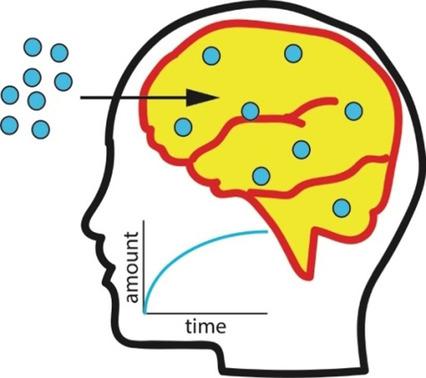当前位置:
X-MOL 学术
›
ChemMedChem
›
论文详情
Our official English website, www.x-mol.net, welcomes your
feedback! (Note: you will need to create a separate account there.)
Modeling the Accumulation of Degradable Polymer Drug Carriers in the Brain
ChemMedChem ( IF 3.6 ) Pub Date : 2018-06-10 , DOI: 10.1002/cmdc.201800186 Celine Bolwerk 1 , Larissa P. M. W. D. Govers 1 , Hanna Knol 1 , Thom F. Oostendorp 2 , Roland Brock 1
ChemMedChem ( IF 3.6 ) Pub Date : 2018-06-10 , DOI: 10.1002/cmdc.201800186 Celine Bolwerk 1 , Larissa P. M. W. D. Govers 1 , Hanna Knol 1 , Thom F. Oostendorp 2 , Roland Brock 1
Affiliation

|
The blood–brain barrier (BBB) limits the access of drugs to the brain. Intensive research is being conducted on the development of nanoparticulate drug carriers that mediate transfer across the BBB. A question that has been neglected so far is the potential accumulation of the carrier in the brain upon long‐term exposure. Here, we address this question by implementing a kinetic model to relate drug loading, required concentration of drug in the brain, and drug clearance to the degradation half‐life of the carrier. As a test case with clinical relevance we chose poly‐lactic‐co‐glycolic‐acid (PLGA) as a carrier material and a chemotherapeutic for which the required parameters could be recovered from the literature. For methotrexate with a drug load of 8.5 %, a required concentration of free drug of 1 μm, a release from PLGA of 6 hours, a drug clearance from the brain of 3 hours and a half‐life of polymer degradation of 28 days, a steady‐state accumulation of 1.3 g polymer would be reached in the brain (1.5 L) after seven months. While this number is surprisingly small, further physiological research is warranted to assess to which degree this will be in a tolerable range.
中文翻译:

模拟大脑中可降解聚合物药物载体的积累
血脑屏障(BBB)限制了药物进入大脑的通道。目前正在对介导跨血脑屏障转移的纳米颗粒药物载体的开发进行深入研究。迄今为止,一个被忽略的问题是长期暴露后大脑中载体的潜在积累。在这里,我们通过建立一个动力学模型来解决这个问题,该模型将载药量,大脑中所需的药物浓度以及药物清除率与载体的降解半衰期相关联。作为具有临床相关性的测试案例,我们选择了聚乳酸-乙醇酸(PLGA)作为载体材料和化学治疗剂,可以从文献中获得所需的参数。对于载药量为8.5%的甲氨蝶呤,所需的游离药物浓度为1μm,从PLGA释放6小时,从大脑清除药物3小时,聚合物半衰期为28天,稳态后在大脑中(1.5 L)积聚1.3 g聚合物(1.5 g)七个月。尽管这个数字小得令人惊讶,但仍需进行进一步的生理学研究,以评估其在可容许的范围内的程度。
更新日期:2018-06-10
中文翻译:

模拟大脑中可降解聚合物药物载体的积累
血脑屏障(BBB)限制了药物进入大脑的通道。目前正在对介导跨血脑屏障转移的纳米颗粒药物载体的开发进行深入研究。迄今为止,一个被忽略的问题是长期暴露后大脑中载体的潜在积累。在这里,我们通过建立一个动力学模型来解决这个问题,该模型将载药量,大脑中所需的药物浓度以及药物清除率与载体的降解半衰期相关联。作为具有临床相关性的测试案例,我们选择了聚乳酸-乙醇酸(PLGA)作为载体材料和化学治疗剂,可以从文献中获得所需的参数。对于载药量为8.5%的甲氨蝶呤,所需的游离药物浓度为1μm,从PLGA释放6小时,从大脑清除药物3小时,聚合物半衰期为28天,稳态后在大脑中(1.5 L)积聚1.3 g聚合物(1.5 g)七个月。尽管这个数字小得令人惊讶,但仍需进行进一步的生理学研究,以评估其在可容许的范围内的程度。











































 京公网安备 11010802027423号
京公网安备 11010802027423号